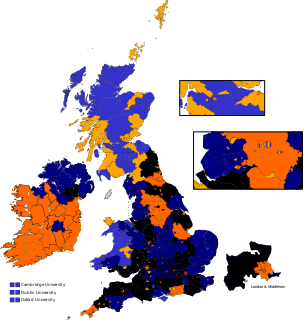
North Devon is a constituency represented in the House of Commons of the UK Parliament since 2019 by Selaine Saxby of the Conservative Party.

Newark is a constituency in Nottinghamshire, England. It is currently represented by Robert Jenrick of the Conservative Party who won the seat in a by-election on 5 June 2014, following the resignation of Patrick Mercer in April 2014.

South Leicestershire is a constituency represented in the House of Commons of the UK Parliament since 2015 by Alberto Costa, a member of the Conservative Party.
Cambridgeshire is a former Parliamentary constituency in the United Kingdom. It was a constituency of the House of Commons of the Parliament of England then of the Parliament of Great Britain from 1707 to 1800 and of the Parliament of the United Kingdom from 1801 to 1885.

South Shropshire is a former United Kingdom Parliamentary constituency. It was a constituency of the House of Commons of the Parliament of the United Kingdom from 1832 to 1885. It was represented by two Knights of the Shire.
Hertford was the name of a parliamentary constituency in Hertfordshire, which elected Members of Parliament (MPs) from 1298 until 1974.

South Lancashire, formally called the Southern Division of Lancashire or Lancashire Southern, is a former county constituency of the South Lancashire area in England. It returned two Members of Parliament (MPs) to the British House of Commons from 1832 to 1861, and then from a very narrow reform of that year, three until it was further split in 1868.
North Northamptonshire was a county constituency in Northamptonshire, represented in the House of Commons of the Parliament of the United Kingdom.

North Lincolnshire, formally known as the Northern Division of Lincolnshire or as Parts of Lindsey, was a county constituency in the Lindsey district of Lincolnshire. It returned two Members of Parliament (MPs) to the House of Commons of the Parliament of the United Kingdom.

West Kent was a county constituency in Kent in South East England. It returned two Members of Parliament (MPs) to the House of Commons of the Parliament of the United Kingdom, elected by the first past the post system.

East Kent was a county constituency in Kent in South East England. It returned two Members of Parliament (MPs) to the House of Commons of the Parliament of the United Kingdom, elected by the first past the post system.

South Northumberland was a county constituency of the House of Commons of the Parliament of the United Kingdom. It was represented by two Members of Parliament (MPs), elected by the intuitive first-past-the-post means where there is more than one member, considered the plurality-at-large bloc vote by global cephologists today.

East Suffolk was a county constituency in Suffolk, England. It returned two Members of Parliament to the House of Commons of the Parliament of the United Kingdom.

West Sussex was a parliamentary constituency in the county of Sussex, which returned two Members of Parliament to the House of Commons of the Parliament of the United Kingdom, elected by the bloc vote system.
North Hampshire was a constituency as one of two in the county of Hampshire proper, which returned two Members of Parliament (MPs) to the House of Commons of the UK Parliament between 1832 and 1885. Its members were elected by the bloc vote version of the first-past-the-post system.

South Hampshire was a parliamentary constituency in the county of Hampshire, which returned two Members of Parliament (MPs) to the House of Commons of the Parliament of the United Kingdom, elected by the bloc vote system.

West Norfolk or Norfolk Western was a county constituency in the county of Norfolk, which returned two Members of Parliament (MPs) to the House of Commons of the Parliament of the United Kingdom, elected by the bloc vote system.

North Nottinghamshire, formally the "Northern Division of Nottinghamshire" was a county constituency represented in the House of Commons of the Parliament of the United Kingdom. It elected two Members of Parliament (MPs) by the block vote system of election.
North Leicestershire, formally the "Northern Division of Leicestershire", was a county constituency represented in the House of Commons of the Parliament of the United Kingdom. It elected two Members of Parliament (MPs) by the bloc vote system of election.

South Lincolnshire, formally called the Southern Division of Lincolnshire or Parts of Kesteven and Holland, was a county constituency in Lincolnshire. It returned two Members of Parliament (MPs) to the House of Commons of the Parliament of the United Kingdom, elected by the bloc vote electoral system.



